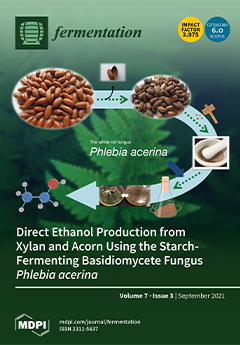Cassava pulp (CS) is high in fiber and low in protein; hence, improving the nutritive value of CS is required to increase its contribution to enhancing ruminant production. The present work hypothesized that CS quality could be enhanced by fermentation with yeast waste (YW), which can be used to replace soybean meal (SBM), as well as lead to improved feed utilization in ruminants. Thus, evaluation of in vitro ruminal fermentation and feed digestibility, as influenced by YW-treated CS and different roughage (R) to concentrate (C) ratios, was elucidated. The design of the experiment was a 5 × 3 factorial arrangement in a completely randomized design. Each treatment contained three replications and three runs. The first factor was replacing SBM with CS fermented with YW (CSYW) in a concentrate ratio at 100:0, 75:25, 50:50, 25:75, and 0:100, respectively. The second factor was R:C ratios at 70:30, 50:50, and 30:70. The level of CSYW showed significantly higher (
p < 0.01) gas production from the insoluble fraction (b), potential extent of gas production (a + b), and cumulative gas production at 96 h than the control group (
p < 0.05). There were no interactions among the CSYW and R:C ratio on the in vitro digestibility (
p > 0.05). Furthermore, increasing the amount of CSYW to replace SBM up to 75% had no negative effect on in vitro neutral detergent fiber degradability (IVNDFD) (
p > 0.05) while replacing CSWY at 100% could reduce IVNDFD (
p > 0.05). The bacterial population in the rumen was reduced by 25.05% when CSYW completely replaced SBM (
p < 0.05); however, 75% of CSWY in the diet did not change the bacterial population (
p > 0.05). The concentration of propionate (C3) decreased upon an increase in the CSYW level, which was lowest with the replacement of SBM by CSYW up to 75%. However, various R:C ratios did not influence total volatile fatty acids (VFAs), and the proportion of VFAs (
p > 0.05), except the concentration of C3, increased when the proportion of a concentrate diet increased (
p < 0.05). In conclusion, CSYW could be utilized as a partial replacement for SBM in concentrate diets up to 75% without affecting gas kinetics, ruminal parameters, or in vitro digestibility.
Full article





